Until recently, "value" and "experience" were only linked with customer satisfaction. And hence, metrics like NPS helped measure customer loyalty. This article shows you the importance of eNPS, or the Employee Net Promoter Score.
However, futuristic companies are well aware how their employees feel about their organization matters just as much. The need for being a people-first brand is stronger than ever. And one metric may hold the key – employee net promoter score (eNPS).
eNPS measures employee advocacy. Put simply, it is a combination of how a team member feels in their role and whether they would recommend your organization to others. It's a pretty good proxy for employee engagement.
Loyal employees in any company create loyal customers, who in turn create happy shareholders.
Richard Branson
eNPS scores for top companies in 2022 may reveal much about their organizational culture. High scores reflect excellent employee satisfaction levels. For instance, 90% of Airbnb employees recommend the company as a great workplace.
So, before discussing companies with the highest eNPS, let's take a deeper look into eNPS and what it entails.
What is the Employee Net Promoter Score?
eNPS stands for Employee Net Promoter Score. It is a scoring system designed to measure employees' sentiment within the company and indicates how likely employees are to promote their organization as a workplace to others. The eNPS survey is based on a straightforward question.
"How willing are you to recommend this organization as a place to work for your family and friends?"
This question is relatively objective and isn't anchored to the organization or individual. While the metric is a simple way to chalk down your employee engagement levels, it must not be confused as the only way to measure employee satisfaction.
Advocacy is not the same as loyalty or happiness. You can have employees who are passionate about what they do and take their work seriously but still leave your organization due to unavoidable circumstances. Similarly, you might have employees who just show up for work to collect a check yet be satisfied.
The ultimate aim of HR leaders must be to improve employee engagement at a broader level, i.e., create a thriving culture.
How to calculate employee net promoter score?
The eNPS is the difference between your happiest (Promoters) and least happy employees (Detractors).
eNPS Formula
eNPS = % Promoters - % Detractors
Let us understand this in detail.
eNPS is about asking 1 simple question, with a choice of answers based on a scale of 1-10:

The answer scale ranges from 0 to 10. Here 10 means "extremely likely", and 0 means "not at all likely." The responses are then divided into the below categories of employees:
-
Promoters: They rate 9 or 10. These are engaged, motivated, inspired, and show organizational commitment. We call these employees “Engaged.”
-
Passives: They rate 7 or 8. Such employees might be satisfied with the experience. However, their level of loyalty may be lower than the promoters. We call these employees “Not engaged.”
-
Detractors: They rate from 0 to 6. These employees are generally disengaged. They lack inspiration and motivation and might not recommend your organization to others. We call such employees “Actively disengaged.”
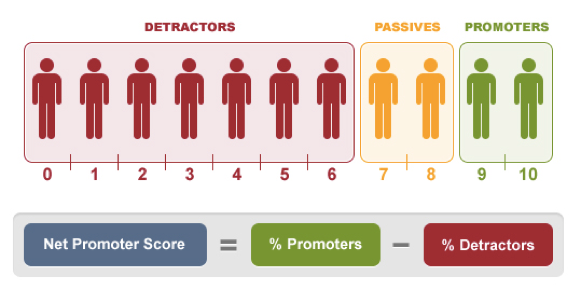
Let's use an example to illustrate the eNPS calculation.
For instance, you have 140 promoters, 60 detractors, and 0 passives. Your promoter percentage is 70, your detractor percentage is 30, and your overall eNPS is 70% - 30% = 40.
Let's see what happens when you have 40 passives as well. The total count of employees is 140+60+40= 240.
Now, your promoter percentage is 58.36%, while the detractor percentage is 25%. The eNPS is 33%.
eNPS scores for top companies 2022
Here are the eNPS of top companies according to employee responses on Comparably and other sources.
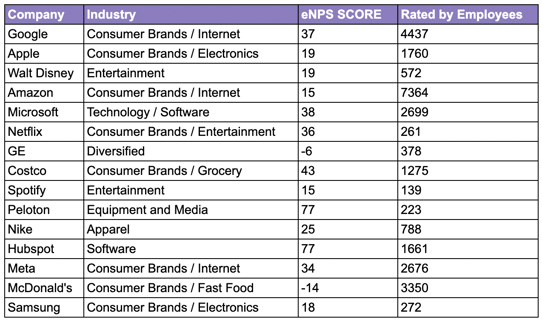
So, what do these scores translate into, specifically?
The above scores are a direct reflection of an organization's culture and employee experience. A strong eNPS score means employees are more likely to recommend their employer as a great workplace. But what do low scores mean?
You know that your detractors and passives are high, but what is the reason for their disengagement?
Hence, when using eNPS, you should always remember that the score itself does not reveal the underlying factors that make people either promoters, passives, or detractors.
So, regardless of the scores, it is crucial to pair the eNPS with other questions that dive deeper into the context of this score. This setup will allow you to dive deep into the actual drivers of employee engagement and, ideally, convert the most disengaged people in your organization into your promoters pool.
Practical considerations in measuring your eNPS score
1. Track eNPS regularly
Like any other feedback cycle, eNPS surveys should follow a structured and cyclical approach. You should measure eNPS at least twice a year and ideally every quarter.
Measuring at specific time frames allows you to benchmark against historical scores and track progress. It also helps you get actionable insights such as your workforce's cultural alignment, passion, commitment, and loyalty.
It helps you tackle obstacles before they become problems. This way, you can tell whether your eNPS is improving against previous periods and it allows you to consistently work to form a better culture.
2. Foster a culture of openness and transparency
One of the challenges in conducting regular surveys is low response rates.
A low participation rate may also skew eNPS results. In such cases, either promoters or detractors are the only ones who voice their opinions. Hence, the score won't give you an accurate picture of what's going on in your business.
Therefore, encourage your employees to provide feedback by fostering openness and transparency. Let your employees know that all answers are confidential and there would be no repercussions whatsoever if they voice their opinions.
Avoid bombarding employees with surveys and reminders, as this might lead to survey fatigue - especially among non-professional workers.
Read our suggestions on mitigating survey fatigue here.
3. Gauge the drivers of eNPS with the help of technology tools
While finding out eNPS itself only requires one question, but you also need to ask other questions to help you give context to this score.
You need to understand the drivers affecting employee engagement to improve your eNPS. It may revolve around compensation, work-life balance, growth opportunities, and more. A deep dive into key drivers of eNPS can help you understand what's working for your organization and what needs improvement.
The below image depicts how platforms like EngageRocket give you the power to make smart decisions based on data and analytics.
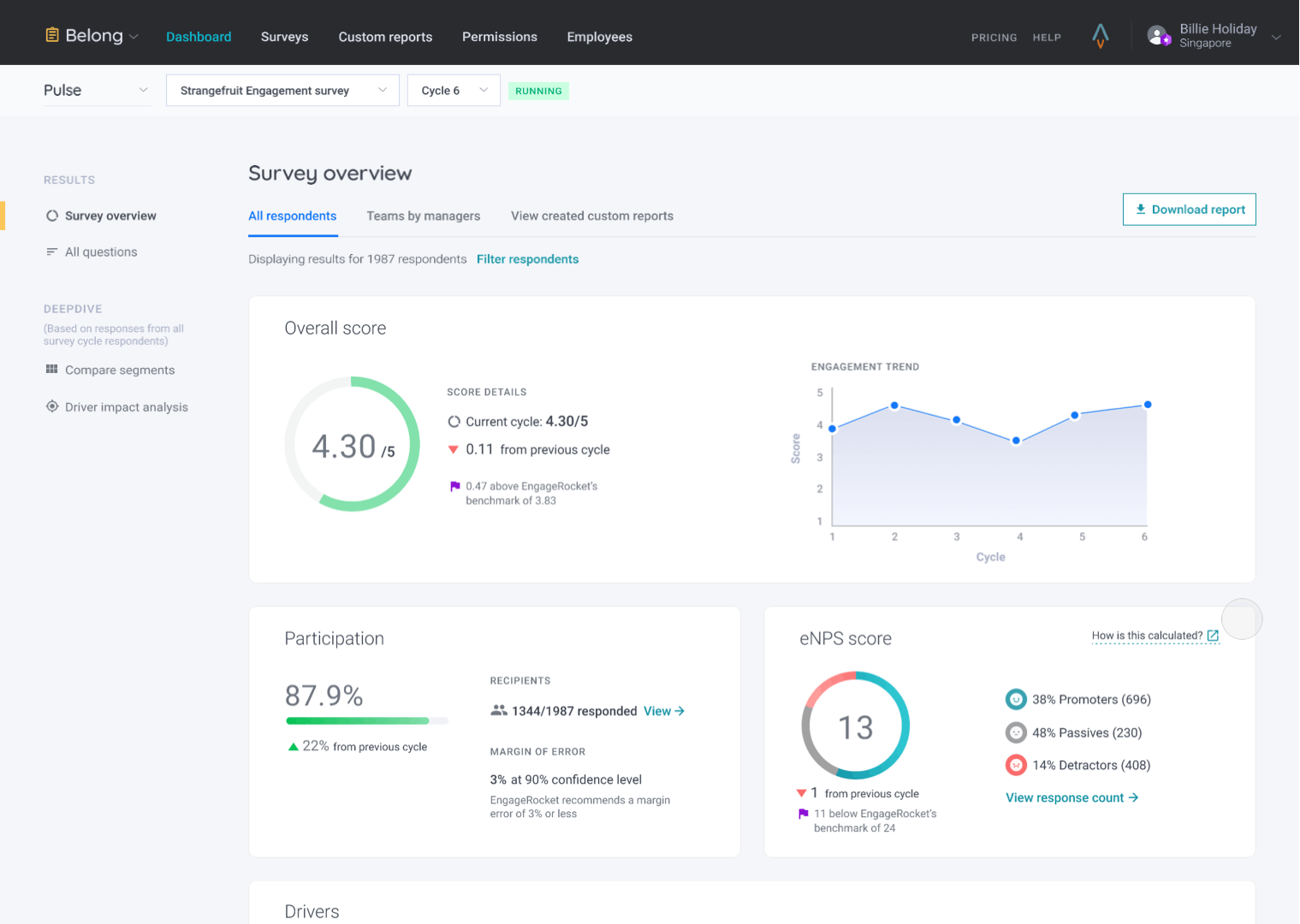
Source: EngageRocket
From this analysis, you can see that the driver "Growth" is high-scoring, and also has a very high impact on eNPS. On the other hand, the driver "Team" is high-scoring, but has a low impact on eNPS.
This view allows you to celebrate your wins, especially on high-scoring and highly impactful drivers. It also helps you prioritize which drivers to act on, especially those that generate low scores but have a high impact on eNPS.
OK, I have a score. What do I do with it?
-
Ask a follow-up "why" question: The real value comes in the follow-up question of “why”. You can ask something like: "What’s the reason for the score you gave?" Basically, anything that lets you dive deeper to find out what contributes to the current state and what could be improved.
-
Share the result with employees: Transparency is always highly encouraged because you want employees to feel involved in improving eNPS. The more your employees feel responsible, the higher the chances of increasing their engagement.
-
Track it continuously: The biggest benefit of the eNPS is that it is a quick way to get an overview of employee advocacy and engagement. To reap the most out of eNPS, it should be a metric that is measured over time as it allows the understanding of different factors that may affect employees over e.g. a year.
-
Benchmark against yourself: Very often, many will want to benchmark themselves against their competitors or other companies within the industry, but benchmarking against other companies isn’t the best way to do it. Instead, you should be benchmarking against yourself. Ask yourself what you can improve internally so that your employees are more likely to be advocates and will be willing to go the extra mile for your customers. At the end of the day, the most useful benchmark a company can use is its own progress over time.
Measure and improve your eNPS with EngageRocket
By now, you know that eNPS scores for top companies reflect how their employees value the organization and how willing they are to promote your organization. However, there are more than meets the eye when it comes to measuring eNPS.
Yet, identifying how your employees feel will significantly benefit your company and the bottom line.
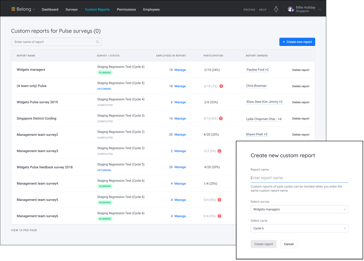
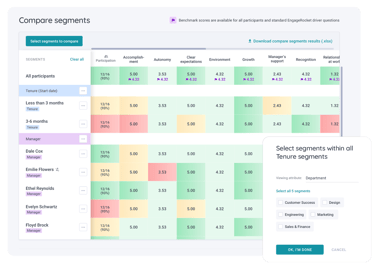
EngageRocket's BELONG platform helps organizations measure eNPS, track engagement drivers, and empower managers with data-driven insights.
Here are some of the advantages of EngageRocket's BELONG platform:
- Quick to set up, seamless to launch, easy to customize. Select the right questions to ask in our library of scientifically validated questions
- Designed with employee confidentiality in mind, so you could encourage honesty and transparency
- Get clear, actionable insights with cutting-edge analytics - in one intuitive dashboard
- Reduce unwanted attrition by identifying the drivers of engagement
Want more content like this?
Join EngageRocket's HR Impact community and get the latest HR resources and exclusive event invites!
Frequently Asked Questions (FAQs)
1. What is a good eNPS score in 2022?
An employee's NPS can range anywhere from -100 to +100. A score of +100 means 100% of your employees are promoters, and a score of -100 implies 100% of employees are detractors. However, the ideal employee net promoter score may vary depending on your industry, demographics, and the profession of the employees.
In general, a good eNPS score ranges between 10 and 30. And a score above 30 is considered to be excellent. However, anything below 10 indicates that you need to take some steps to improve your employee engagement.
2. Which is better, NPS or eNPS?
An NPS survey asks customers whether or not they would recommend a product to their friends or family. Similarly, eNPS surveys ask whether or not the employee would recommend the company to friends and family.
Since both employees and customers are critical for business growth, both metrics are equally important. In a nutshell, both NPS and eNPS directly reflect upon the company's brand and must be measured regularly.
3. How do you interpret the eNPS score?
Interpreting eNPS scores is pretty simple. Higher scores represent a higher level of employee satisfaction and vice versa. However, the challenging part is benchmarking the eNPS scores since they vary relatively across different sectors. Hence, it's ideal for HR leaders to benchmark their eNPS against past results.
4. What is a bad eNPS score?
A negative eNPS score means there are more detractors than promoters in your organization. It often suggests an underlying issue with the company culture, management, and engagement.
While there are no general benchmarks for a poor score, you must investigate and take drastic measures if your eNPS is negative.




 .
. 